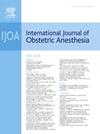连续超声心动图测量健康患者脊髓麻醉后计划剖宫产的心输出量:一项前瞻性观察研究
IF 2.3
3区 医学
Q2 ANESTHESIOLOGY
引用次数: 0
摘要
背景:评估剖宫产时心输出量的研究结果是相互矛盾的。经胸超声心动图已应用于产科麻醉研究和临床实践。我们使用经胸超声心动图来评估健康患者剖宫产术后脊髓麻醉后心排血量的变化。方法对60例足月单胎妊娠患者进行单臂前瞻性观察研究。患者在10分钟内接受1000 mL晶体负载;重复麻黄碱丸治疗收缩压分别为基线的90% (3mg)、80% (5mg)和70% (10mg);10 IU/30分钟催产素输注。经胸超声心动图分别在基线、鞘内注射后10分钟、分娩后立即和鞘内注射后1小时进行。主要结局是脊髓麻醉后心输出量随时间的变化。次要结局是卒中量和心率的一系列变化,接受麻黄碱治疗的患者数量,低血压、严重低血压、心动过缓和恶心/呕吐的发生率。结果平均±标准差基线心输出量为5601±1430 mL/min,每搏量为61±14.8 mL,心率为92±7.8次/min。鞘内注射1小时后,心输出量和每搏量增加。脊髓麻醉后和分娩后心率升高,并在鞘内注射后1小时恢复到接近基线。结论脊髓麻醉后使用晶体剂、麻黄碱、催产素后心输出量增加(同时伴有脑卒中量增加),分娩后立即达到最高值。经胸超声心动图在剖宫产术中监测血流动力学是可行和适用的。本文章由计算机程序翻译,如有差异,请以英文原文为准。
Serial echocardiographic measurements of cardiac output after spinal anesthesia for scheduled cesarean delivery in healthy patients: a prospective observational study
Background
Results of studies assessing cardiac output during cesarean delivery are conflicting. Transthoracic echocardiography has been applied in obstetric anesthesia research and clinical practice. We used transthoracic echocardiography to evaluate changes in cardiac output after spinal anesthesia for scheduled cesarean delivery in healthy patients.
Methods
This single-arm, prospective observational study was conducted on 60 patients with full-term, singleton pregnancy. Patients received 1000 mL crystalloid coload over 10 minutes; rescue repeated ephedrine bolus for systolic blood pressure <90% (3 mg), 80% (5 mg), and 70% (10 mg) of baseline, respectively; and 10 IU/30 minutes oxytocin infusion. Transthoracic echocardiography was performed at baseline, 10 minutes after intrathecal injection, immediately after delivery, and 1 hour after intrathecal injection. Primary outcome was serial changes in cardiac output over time after spinal anesthesia. Secondary outcomes were serial changes in stroke volume and heart rate, number of patients receiving ephedrine, and incidence of hypotension, severe hypotension, bradycardia, and nausea/vomiting.
Results
Mean ± standard devliation baseline cardiac output, stroke volume, and heart rate was 5601 ± 1430 mL/min, 61 ± 14.8 mL, and 92 ± 7.8 beats/min, respectively. Cardiac output and stroke volume increased over time lasting for 1 hour after intrathecal injection. Heart rate increased after spinal anesthesia and after delivery and returned to near baseline 1 h after intrathecal injection.
Conclusions
Using crystalloid coload, ephedrine boluses, and oxytocin infusion, cardiac output increased (accompanied with parallel increase in stroke volume) after spinal anesthesia, with highest values immediately after delivery. Transthoracic echocardiography was feasible and applicable for hemodynamic monitoring during cesarean delivery.
求助全文
通过发布文献求助,成功后即可免费获取论文全文。
去求助
来源期刊
CiteScore
4.70
自引率
7.10%
发文量
285
审稿时长
58 days
期刊介绍:
The International Journal of Obstetric Anesthesia is the only journal publishing original articles devoted exclusively to obstetric anesthesia and bringing together all three of its principal components; anesthesia care for operative delivery and the perioperative period, pain relief in labour and care of the critically ill obstetric patient.
• Original research (both clinical and laboratory), short reports and case reports will be considered.
• The journal also publishes invited review articles and debates on topical and controversial subjects in the area of obstetric anesthesia.
• Articles on related topics such as perinatal physiology and pharmacology and all subjects of importance to obstetric anaesthetists/anesthesiologists are also welcome.
The journal is peer-reviewed by international experts. Scholarship is stressed to include the focus on discovery, application of knowledge across fields, and informing the medical community. Through the peer-review process, we hope to attest to the quality of scholarships and guide the Journal to extend and transform knowledge in this important and expanding area.

 求助内容:
求助内容: 应助结果提醒方式:
应助结果提醒方式:


